Potrebujeme váš súhlas na využitie jednotlivých dát, aby sa vám okrem iného mohli ukazovať informácie týkajúce sa vašich záujmov. Súhlas udelíte kliknutím na tlačidlo „OK“.
ASTM E903-12
Standard Test Method for Solar Absorptance, Reflectance, and Transmittance of Materials Using Integrating Spheres
Automaticky preložený názov:
Štandardná skúšobná metóda pre absorpciu slnečného žiarenia, odrazivosť, a Transmittance materiálov pomocou Integrácia gule
NORMA vydaná dňa 1.12.2012
Informácie o norme:
Označenie normy: ASTM E903-12
Poznámka: NEPLATNÁ
Dátum vydania normy: 1.12.2012
Kód tovaru: NS-48424
Počet strán: 17
Približná hmotnosť: 51 g (0.11 libier)
Krajina: Americká technická norma
Kategória: Technické normy ASTM
Kategórie - podobné normy:
Anotácia textu normy ASTM E903-12 :
Keywords:
absorptance, diffuse, integrating sphere, reflectance, smooth, solar absorptance, solar reflectance, solar transmittance, spectral, spectrophotometer, specular, texture, transmittance, ICS Number Code 77.140.80 (Iron and steel castings)
Doplňujúce informácie
| Significance and Use | ||||||||||||||||||||||
|
5.1 Solar-energy absorptance, reflectance, and transmittance are important in the performance of all solar energy systems ranging from passive building systems to central receiver power systems. This test method provides a means for determining these values under fixed conditions that represent an average that would be encountered during use of a system in the temperate zone. 5.2 Solar-energy absorptance, reflectance, and transmittance are important for thermal control of spacecraft and the solar power of extraterrestrial systems. This test method also provides a means for determining these values for extraterrestrial conditions. 5.3 This test method is designed to provide reproducible data appropriate for comparison of results among laboratories or at different times by the same laboratory and for comparison of data obtained on different materials. 5.4 This test method has been found practical for smooth materials having both specular and diffuse optical properties. Materials that are textured, inhomogeneous, patterned, or corrugated require special consideration. 5.4.1 Surface roughness may be introduced by physical or chemical processes, such as pressing, rolling, etching, or deposition of films or chemical layers on materials, resulting in textured surfaces. 5.4.2 The magnitude of surface roughness with respect to the components of the spectrophotometer and attachments (light beam sizes, sphere apertures, sample holder configuration) can significantly affect the accuracy of measurements using this test method. 5.4.3 Even if the repeatability, or precision of the measurement of textured materials is good, including repeated measurements at various locations within or orientations of the sample, the different characteristics of different spectrophotometers in different laboratories may result in significant differences in measurement results. 5.4.4 In the context of 5.4.3, the term ‘significant’ means differences exceeding the calibration or measurement uncertainty, or both, established for the spectrophotometers involved, through measurement of or calibration with standard reference materials. 5.4.5 The caveats of 5.4.3 and 5.4.4 apply as well to measurement of smooth inhomogeneous or diffusing materials, where incident light may propogate to the edge of the test material and be ‘lost’ with respect to the measurement. 5.5 This test method describes measurements accomplished over wider spectral ranges than the Photopic response of the human eye. Measurements are typically made indoors using light sources other than natural sunlight, though it is possible to configure systems using natural sunlight as the illumination source, as in Practice E424. Practice E971 describes outdoor methods using natural sunlight over the spectral response range of the human eye. 5.6 Light diffracted by gratings is typically significantly polarized. For polarizing samples, measurement data will be a function of the orientation of the sample. Polarization effects may be detected by measuring the sample with rotation at various angles about the normal to the samples. |
||||||||||||||||||||||
| 1. Scope | ||||||||||||||||||||||
|
1.1 This test method covers the measurement of spectral absorptance, reflectance, and transmittance of materials using spectrophotometers equipped with integrating spheres. 1.2 Methods of computing solar weighted properties from the measured spectral values are specified. 1.3 This test method is applicable to materials having both specular and diffuse optical properties. 1.4 This test method is applicable to material with applied optical coatings with special consideration for the impact on the textures of the material under test. 1.5 Transmitting sheet materials that are inhomogeneous, textured, patterned, or corrugated require special considerations with respect to the applicability of this test method. Test Method E1084 may be more appropriate to determine the bulk optical properties of textured or inhomogeneous materials. 1.6 For homogeneous materials this test method is preferred over Test Method E1084. 1.7 This test method refers to applications using standard reference solar spectral distributions but may be applied using alternative selected spectra as long as the source and details of the solar spectral distribution and weighting are reported. 1.8 This standard does not purport to address all of the safety concerns, if any, associated with its use. It is the responsibility of the user of this standard to establish appropriate safety and health practices and determine the applicability of regulatory limitations prior to use. |
||||||||||||||||||||||
| 2. Referenced Documents | ||||||||||||||||||||||
|
Podobné normy:
Historická
1.12.2012
Historická
15.1.2009
Historická
1.4.2009
Historická
1.6.2013
Historická
1.9.2013
Historická
1.12.2012


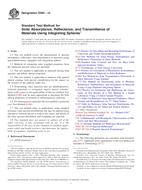
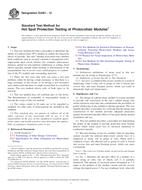 ASTM E2481-12
ASTM E2481-12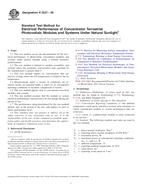 ASTM E2527-09
ASTM E2527-09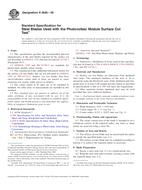 ASTM E2685-09
ASTM E2685-09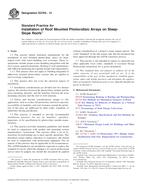 ASTM E2766-13
ASTM E2766-13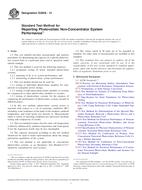 ASTM E2848-13
ASTM E2848-13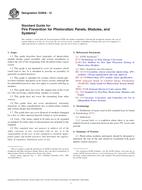 ASTM E2908-12
ASTM E2908-12
 Cookies
Cookies
